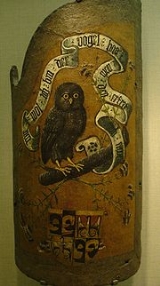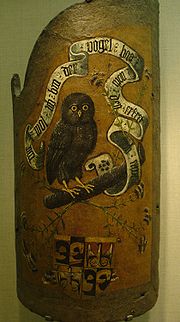
Targe
Encyclopedia

Shield
A shield is a type of personal armor, meant to intercept attacks, either by stopping projectiles such as arrows or redirecting a hit from a sword, mace or battle axe to the side of the shield-bearer....
in late Old English
Old English language
Old English or Anglo-Saxon is an early form of the English language that was spoken and written by the Anglo-Saxons and their descendants in parts of what are now England and southeastern Scotland between at least the mid-5th century and the mid-12th century...
. Its diminutive, target, came to mean an object to be aimed at in the 18th century.
The term refers to various types of shields used by infantry troops from the 13th to 16th centuries. More specifically, a targe was a concave shield fitted with enarmes
Enarmes
Enarmes are the leather gripping straps attached to the back of shields throughout the Medieval period.Enarmes represented a significant advance in shield technology, as beforehand shields were held by a single bar that ran behind a boss. Enarmes were held in place by riveting through the leather...
on the inside, one adjustable by a buckle, to be attached to the forearm, and the other fixed as a grip for the left hand. These shields were mostly made of iron or iron-plated wood. From the 15th century, the term could also refer to special shields used for jousting
Jousting
Jousting is a martial game or hastilude between two knights mounted on horses and using lances, often as part of a tournament.Jousting emerged in the High Middle Ages based on the military use of the lance by heavy cavalry. The first camels tournament was staged in 1066, but jousting itself did not...
.
From the early 17th century, until the Battle of Culloden
Battle of Culloden
The Battle of Culloden was the final confrontation of the 1745 Jacobite Rising. Taking place on 16 April 1746, the battle pitted the Jacobite forces of Charles Edward Stuart against an army commanded by William Augustus, Duke of Cumberland, loyal to the British government...
in 1746, the Scottish Highlander
Scottish Highlands
The Highlands is an historic region of Scotland. The area is sometimes referred to as the "Scottish Highlands". It was culturally distinguishable from the Lowlands from the later Middle Ages into the modern period, when Lowland Scots replaced Scottish Gaelic throughout most of the Lowlands...
's main means of defence in battle was his targe.http://www.highlandtarge.com/xmark/cross-front1-600.jpghttp://www.highlandtarge.com/xmark/cross-back-600.jpg After the disastrous defeat of the Jacobites
Jacobitism
Jacobitism was the political movement in Britain dedicated to the restoration of the Stuart kings to the thrones of England, Scotland, later the Kingdom of Great Britain, and the Kingdom of Ireland...
at Culloden, the carrying of the targe would have been banned, and many would have been destroyed, or put to other uses. Those that remain have intricate patterns, and are well decorated, indicating that they would have originally belonged to important people.
Structure of the Scottish targe
Targes are generally, but not always, round shields between 18 in and 21 in (45–55 cm) in diameter. The inside of the targe was formed from two very thin layers of flat wooden boards, with the grainWood grain
In speaking of wood the term grain refers to the alternating regions of relatively darker and lighter wood resulting from the differing growth parameters occurring in different seasons . The term is used in several ways. Perhaps most important is that in woodworking techniques...
of each layer at right angles to the other. They were fixed together with small wooden pegs, forming plywood
Plywood
Plywood is a type of manufactured timber made from thin sheets of wood veneer. It is one of the most widely used wood products. It is flexible, inexpensive, workable, re-usable, and can usually be locally manufactured...
. The front was covered with a tough cowhide, which was often decorated with embossed celtic style
Celtic art
Celtic art is the art associated with the peoples known as Celts; those who spoke the Celtic languages in Europe from pre-history through to the modern period, as well as the art of ancient peoples whose language is uncertain, but have cultural and stylistic similarities with speakers of Celtic...
patterns. This was fixed to the wood with many brass, or in some cases, silver, nails, and occasionally brass plates were also fixed to the face for strength and decoration. Some targes had center bosses
Shield boss
A shield boss, or umbo, is a round, convex or conical piece of material at the centre of a shield. Shield bosses are usually made of thick metal but could also be made of wood. The boss was originally designed to deflect blows from the centre of round shields, though they also provided a place...
of brass, and a few of these could accept a long steel spike, which screwed into a small "puddle" of lead that was fixed to the wood, under the boss. When not in use, the spike could be unscrewed and placed in a sheath on the back of the targe. A Highlander armed with a broadsword in one hand, dagger in the other and a spiked targe on his arm would have been a formidable enemy in close combat.
The back of the targe was commonly covered in deerskin, and a very few had some packing of straw etc. behind this. Some targes, usually those actually used in battle, had their backs covered in a piece of red cloth taken from the uniform of a government soldier (a "Redcoat") that the owner had killed in battle. Although all the old targes show signs of handles and arm straps, of various designs including centre-grips, there is very little evidence to indicate that there was any guige
Guige
A guige is a long strap, typically made of leather, used to hang a shield on the shoulder or neck. This technique was primarily done when the shield was not in use...
strap for carrying the targe over the shoulder.
The face of a targe typically used two general patterns - concentric circles, or a centre boss with subsidiary bosses around this. There are a few notable exceptions, such as a targe in Perth Museum
Perth Museum and Art Gallery
Perth Museum and Art Gallery is the main museum and exhibition space in the city of Perth, Scotland.It is located on George Street in a building dating back to 1824 and substantially extended by the art gallery in 1932-35.-External links:*...
in Scotland that is of a star design. Although some targe designs appear to have been more popular than others, there is very little to indicate that there ever were "clan" designs. The nearest that one might come to finding a "clan" design is four identical targes from the family armoury at Castle Grant
Clan Grant
-Origins:The Grants are one of the clans of Siol Alpin, and descend from the 9th century Kenneth MacAlpin, King of Scots; and also of Norse origin, from settlers who are the descents of Haakon inn Riki Sigurdarsson , Jarl of Hladr, Protector of Norway ,-Origins:The Grants are one of the clans of...
. It appears more likely that targe designs were individual to their owner. During the 1745/46 Jacobite uprising, a William Lindsay, a shieldwright in Perth made hundreds of targes for Charles Edward Stuart
Charles Edward Stuart
Prince Charles Edward Louis John Casimir Sylvester Severino Maria Stuart commonly known as Bonnie Prince Charlie or The Young Pretender was the second Jacobite pretender to the thrones of Great Britain , and Ireland...
's army. He made a distinction in price between an "officer's targe" and an ordinary targe.

